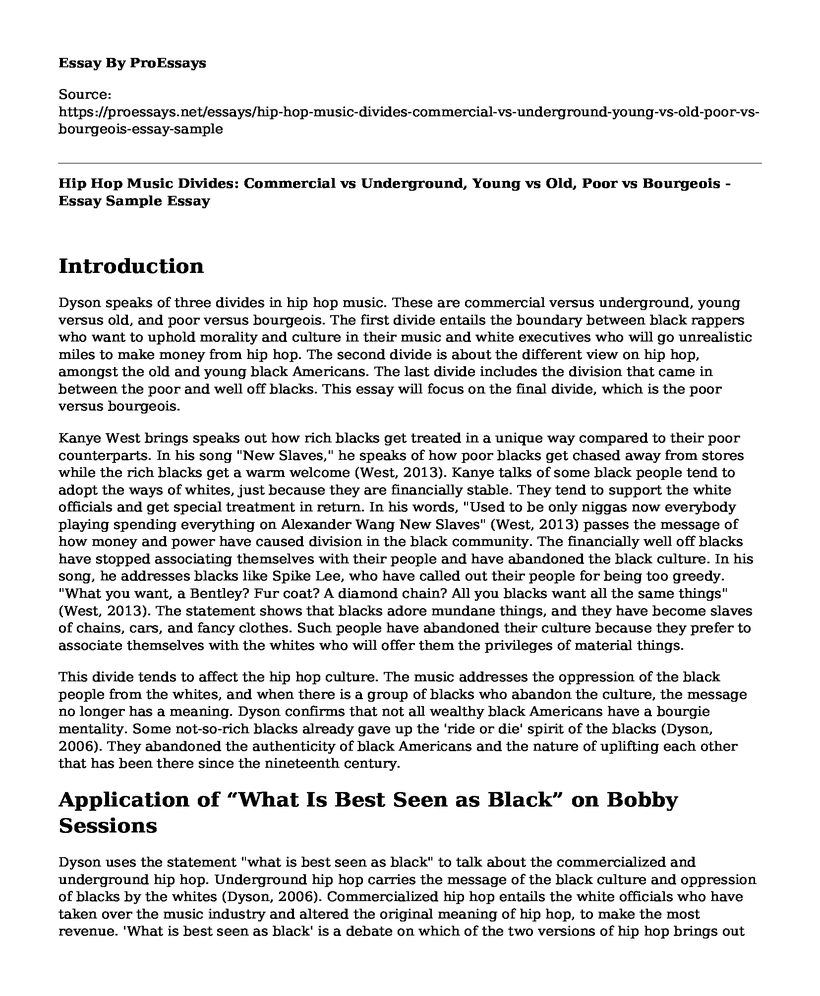Introduction
Dyson speaks of three divides in hip hop music. These are commercial versus underground, young versus old, and poor versus bourgeois. The first divide entails the boundary between black rappers who want to uphold morality and culture in their music and white executives who will go unrealistic miles to make money from hip hop. The second divide is about the different view on hip hop, amongst the old and young black Americans. The last divide includes the division that came in between the poor and well off blacks. This essay will focus on the final divide, which is the poor versus bourgeois.
Kanye West brings speaks out how rich blacks get treated in a unique way compared to their poor counterparts. In his song "New Slaves," he speaks of how poor blacks get chased away from stores while the rich blacks get a warm welcome (West, 2013). Kanye talks of some black people tend to adopt the ways of whites, just because they are financially stable. They tend to support the white officials and get special treatment in return. In his words, "Used to be only niggas now everybody playing spending everything on Alexander Wang New Slaves" (West, 2013) passes the message of how money and power have caused division in the black community. The financially well off blacks have stopped associating themselves with their people and have abandoned the black culture. In his song, he addresses blacks like Spike Lee, who have called out their people for being too greedy. "What you want, a Bentley? Fur coat? A diamond chain? All you blacks want all the same things" (West, 2013). The statement shows that blacks adore mundane things, and they have become slaves of chains, cars, and fancy clothes. Such people have abandoned their culture because they prefer to associate themselves with the whites who will offer them the privileges of material things.
This divide tends to affect the hip hop culture. The music addresses the oppression of the black people from the whites, and when there is a group of blacks who abandon the culture, the message no longer has a meaning. Dyson confirms that not all wealthy black Americans have a bourgie mentality. Some not-so-rich blacks already gave up the 'ride or die' spirit of the blacks (Dyson, 2006). They abandoned the authenticity of black Americans and the nature of uplifting each other that has been there since the nineteenth century.
Application of “What Is Best Seen as Black” on Bobby Sessions
Dyson uses the statement "what is best seen as black" to talk about the commercialized and underground hip hop. Underground hip hop carries the message of the black culture and oppression of blacks by the whites (Dyson, 2006). Commercialized hip hop entails the white officials who have taken over the music industry and altered the original meaning of hip hop, to make the most revenue. 'What is best seen as black' is a debate on which of the two versions of hip hop brings out the best view on black people.
"Can't truss it by Public Enemy tends to provide an answer to the discussion. The song leans on the side of underground hip hop because it talks about the hardships that black Americans went through, while in the hands of the white officials. Public Enemy says that he knows where he comes from, and that is the eras when the black people faced great oppressed by the whites (Hung, 2016). He portrays the idea of black authenticity through the production of music that reflects their culture. 'What is best seen as black' is something that reflects the black history and culture.
In his discussion, Dyson talks of how white people corporations have altered the meaning of hip hop, by producing music that barely reflects the black history. The whites do not relate to the history of blacks because they were their oppressors. They have, therefore, invaded the hip hop world and came up with their ways of how to produce the music (Hung, 2016). However, underground musicians like Public Enemy still hold on to the true meaning and purpose of hip hop music.
References
Dyson (2006). Chapter One: "How Real is This?" (By DYSON, EDITION: 07PUBLISHER: HACHETTE B ISBN: 9780465017164)
Hung, A. (2016). Can't Truss it (lyrics). Retrieved from https://www.youtube.com/watch?v=zTm8mwtQvYAWest, K. (2013). New Slaves. Retrieved from https://www.youtube.com/watch?v=-SoKFycTmVU
Cite this page
Hip Hop Music Divides: Commercial vs Underground, Young vs Old, Poor vs Bourgeois - Essay Sample. (2023, Mar 25). Retrieved from https://proessays.net/essays/hip-hop-music-divides-commercial-vs-underground-young-vs-old-poor-vs-bourgeois-essay-sample
If you are the original author of this essay and no longer wish to have it published on the ProEssays website, please click below to request its removal:
- Social Comparison Orientation Influence in Social Media
- Weaknesses of Facebook's Privacy Policies and Features Essay
- American Innovators: Miles Davis and Steve Reich
- The New Jersey Devils Hockey Arena Case Study
- Movie Analysis Essay on Slumdog Millionaire
- Symbolism and Perspective Essay
- Monologue of Olive's "Little Miss Sunshine"







